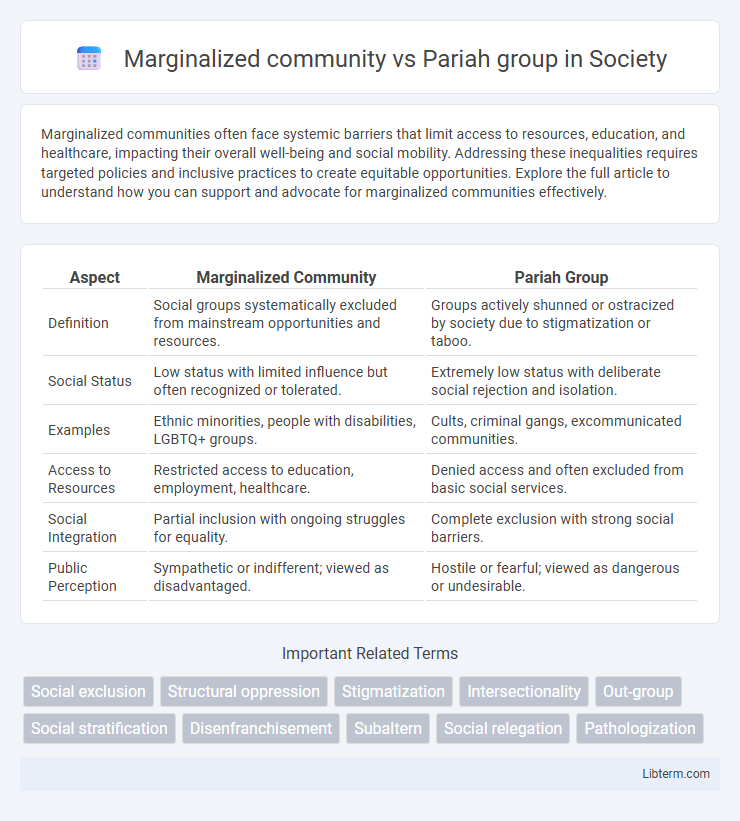Marginalized communities often face systemic barriers that limit access to resources, education, and healthcare, impacting their overall well-being and social mobility. Addressing these inequalities requires targeted policies and inclusive practices to create equitable opportunities. Explore the full article to understand how you can support and advocate for marginalized communities effectively.
Table of Comparison
| Aspect | Marginalized Community | Pariah Group |
|---|---|---|
| Definition | Social groups systematically excluded from mainstream opportunities and resources. | Groups actively shunned or ostracized by society due to stigmatization or taboo. |
| Social Status | Low status with limited influence but often recognized or tolerated. | Extremely low status with deliberate social rejection and isolation. |
| Examples | Ethnic minorities, people with disabilities, LGBTQ+ groups. | Cults, criminal gangs, excommunicated communities. |
| Access to Resources | Restricted access to education, employment, healthcare. | Denied access and often excluded from basic social services. |
| Social Integration | Partial inclusion with ongoing struggles for equality. | Complete exclusion with strong social barriers. |
| Public Perception | Sympathetic or indifferent; viewed as disadvantaged. | Hostile or fearful; viewed as dangerous or undesirable. |
Defining Marginalized Communities and Pariah Groups
Marginalized communities are social groups systematically excluded from mainstream economic, social, political, or cultural life, often facing barriers in education, employment, and access to services. Pariah groups experience extreme social rejection and stigmatization, positioned outside acceptable societal norms, resulting in blatant discrimination and ostracism. Both concepts highlight different levels and types of social exclusion, with marginalized communities enduring disadvantage and limited power, while pariah groups face active societal condemnation and isolation.
Historical Origins of Marginalization and Pariah Status
Marginalized communities have historically faced systemic exclusion rooted in socioeconomic inequalities, cultural discrimination, and political disenfranchisement, often perpetuated by colonialism, slavery, or caste systems. Pariah groups, distinct in their complete social ostracism, originate from deeply ingrained stigmatization tied to perceived impurity, criminality, or religious taboos, such as the Dalits in India or certain ethnic minorities subjected to untouchability. Both concepts reveal entrenched social hierarchies, but pariah status implies an intensified level of social rejection that transcends economic or political marginalization to include ritual or moral impurity.
Social Stigma and Cultural Perceptions
Marginalized communities experience social stigma rooted in systemic exclusion and cultural biases that limit access to resources and opportunities, reinforcing negative stereotypes. Pariah groups face intense social ostracism and condemnation due to cultural perceptions that label them as threats to societal norms or morality. Both groups endure cultural marginalization, but pariah status implies deeper vilification and active shunning by the dominant society.
Power Dynamics: Exclusion vs. Outcast
Marginalized communities experience systemic exclusion through limited access to resources, political representation, and social inclusion, reflecting entrenched power imbalances that uphold dominant group interests. Pariah groups face a more intense form of power dynamic, being actively stigmatized and socially ousted, often labeled as threats or enemies, which reinforces their outcast status and justifies exclusionary practices. The distinction between exclusion and outcast highlights disparities in societal power structures where marginalized communities are denied full participation, while pariah groups endure pervasive rejection and isolation.
Legal and Institutional Responses
Marginalized communities often face systemic barriers within legal frameworks, resulting in limited access to justice and institutional resources, whereas pariah groups are frequently subject to explicit legal exclusion or criminalization. Institutional responses to marginalized communities emphasize inclusion policies and anti-discrimination laws, while pariah groups encounter more punitive measures such as surveillance, arrests, and formal sanctions. Legal systems may struggle to balance protection of societal norms with safeguarding the rights of both marginalized communities and pariah groups, often reflecting broader social stigmatization.
Representation in Media and Literature
Representation in media and literature often depicts marginalized communities with limited scope, emphasizing systemic challenges and underrepresentation, which affects public perception and policy influence. Pariah groups, frequently portrayed as social outcasts or threats, suffer from stigmatized narratives that reinforce exclusion and bias rather than fostering understanding or visibility. Accurate and nuanced representation of both marginalized communities and pariah groups is essential to challenging stereotypes and promoting social inclusion through diversified storytelling.
Economic Impacts and Opportunities
Marginalized communities often face systemic barriers that limit access to economic resources, employment, and financial services, resulting in persistent poverty and reduced social mobility. Pariah groups experience extreme social exclusion and discrimination that severely restricts their participation in mainstream economic activities, often relegating them to informal or subsistence economies. Targeted development programs and inclusive policies can unlock economic opportunities for both groups, fostering entrepreneurship, job creation, and equitable growth.
Identity, Agency, and Collective Voice
Marginalized communities often experience systemic exclusion that limits their identity expression and diminishes their agency in societal decision-making processes, yet they maintain a collective voice through organized activism and advocacy. Pariah groups face extreme social ostracism and stigmatization, resulting in suppressed identities and near-total loss of agency, with their collective voice frequently silenced or delegitimized by dominant cultural narratives. Both classifications highlight critical challenges in combating social injustice, but marginalized communities retain pathways for resistance, while pariah groups endure profound isolation and invisibility.
Strategies for Inclusion and Empowerment
Marginalized communities often benefit from targeted policies such as affirmative action, community-driven development programs, and facilitated access to education and healthcare, which collectively promote inclusion and empowerment. Pariah groups, facing deeper social ostracism, require multifaceted approaches encompassing legal protections against discrimination, grassroots advocacy to shift public perception, and cultural preservation initiatives to reinforce identity and self-worth. Empowerment strategies hinge on amplifying marginalized voices through participatory governance and fostering socio-economic opportunities that dismantle systemic barriers.
Reimagining Social Integration and Justice
Marginalized communities experience systemic exclusion from social, economic, and political opportunities, challenging efforts to achieve equitable justice and integration. Pariah groups face pervasive stigmatization and social rejection, necessitating transformative approaches that reimagine inclusion beyond conventional frameworks of tolerance. Innovative policies must address power imbalances and foster participatory justice to create sustainable pathways for social integration and empowerment.
Marginalized community Infographic

 libterm.com
libterm.com